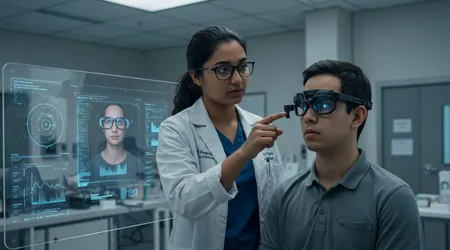AI-Powered Eye Movement Tools for Nonverbal Users: What’s New

AI-powered eye movement tools are revolutionizing how nonverbal individuals communicate, interact, and engage with the world.
In 2025, these technologies have surged forward, blending cutting-edge artificial intelligence with precise eye-tracking systems to empower users with conditions like cerebral palsy, ALS, or severe autism.
Imagine a world where a glance can compose a symphony of words or navigate a digital landscape this is no longer a dream but a reality.
This article dives into the latest advancements, exploring how these tools are reshaping accessibility, their real-world applications, and the challenges ahead.
From intuitive interfaces to real-time adaptability, we’ll uncover why these innovations matter and what’s next for this transformative field.
The journey of assistive technology has always been about breaking barriers. For nonverbal users, who often rely on subtle eye movements to express themselves, AI-powered eye movement tools offer a lifeline.
These systems translate gaze into actionable commands, enabling communication, creativity, and independence. Recent developments have made these tools faster, more accurate, and accessible, driven by AI’s ability to learn and adapt.
With global demand for inclusive tech growing, companies are racing to refine these systems, making them more affordable and versatile.
This article will explore the latest breakthroughs, their impact, and the ethical questions they raise, all while highlighting real-world stories of transformation.
The Evolution of Eye-Tracking Technology
Eye-tracking technology has come a long way since its clunky beginnings. Early systems were slow, expensive, and required extensive calibration, limiting their reach.
Today, AI-powered eye movement tools leverage machine learning to streamline calibration and enhance precision. For instance, modern systems can adapt to a user’s unique eye movements in seconds, learning from subtle patterns to predict intent.
This leap is driven by AI algorithms that process vast datasets, making devices responsive to diverse users, including those with involuntary movements.
Consider Jane, a 14-year-old with Rett syndrome. Using an AI-powered eye movement tool, she now writes poetry by selecting words with her gaze. The system’s AI adjusts to her tremors, ensuring accurate selections.
This personalization is key unlike older models, today’s tools learn in real-time, reducing frustration. Companies like Tobii Dynavox have integrated cloud-based AI to refine gaze detection, cutting calibration time by 40% compared to 2020 models.
++ How Tech Conferences Are Becoming More Inclusive
These advancements make communication seamless, giving users like Jane a voice.
The global impact is significant. A 2023 study by the World Health Organization estimated that 1.3 billion people live with significant disabilities, many of whom could benefit from assistive tech.
AI-powered eye movement tools are bridging this gap, but accessibility remains a hurdle. High costs and limited availability in low-income regions restrict adoption.
Innovators are now exploring smartphone-based eye-tracking, which could democratize access. This shift promises to make these tools a global game-changer, empowering millions.

Real-World Applications Transforming Lives
The practical uses of AI-powered eye movement tools extend far beyond communication. These systems now integrate with smart homes, allowing users to control lights, thermostats, or even wheelchairs with a glance.
For example, Michael, a veteran with ALS, uses his eye-tracking device to adjust his home’s environment, maintaining independence.
The AI’s ability to interpret nuanced gaze patterns ensures precise control, even as his condition progresses. This adaptability is a hallmark of 2025’s innovations.
In education, these tools are leveling the playing field. Schools are adopting AI-powered eye movement tools to help nonverbal students participate in classes.
Software like Grid 3 now supports dynamic grids that adjust based on user fatigue, ensuring consistent performance.
Also read: Inclusive Gaming: How Developers Are Building for Everyone
This fosters inclusion, letting students engage in discussions or complete assignments. Imagine a child crafting a science project presentation with just their eyes such stories are becoming common, reshaping how we view ability.
Creative expression is another frontier. Artists with mobility challenges are using AI-powered eye movement tools to paint digitally or compose music. Platforms like EyeGaze Edge integrate with creative software, translating gaze into brushstrokes or musical notes.
This isn’t just technology it’s liberation, allowing users to share their inner worlds. Yet, challenges persist, like ensuring these tools are intuitive for first-time users. Training programs and user-friendly interfaces are critical to unlocking their full potential.
Ethical and Accessibility Challenges
As AI-powered eye movement tools advance, ethical questions loom large. Who controls the data generated by a user’s gaze?
AI systems rely on sensitive information to function, raising privacy concerns. In 2024, a European Union report highlighted risks of data misuse in assistive tech, urging stricter regulations.
Developers must balance innovation with trust, ensuring users’ personal data remains secure. Transparency in how AI processes gaze data is non-negotiable.
Cost remains a barrier. While prices have dropped, high-end systems still cost thousands, out of reach for many. Subsidies and open-source solutions are emerging, but progress is slow.
In rural areas, access to training or technical support is limited, hindering adoption. Why should life-changing tech be a privilege rather than a right?
Addressing this requires collaboration between governments, NGOs, and tech firms to prioritize equity.
Cultural and linguistic diversity also poses challenges. Many AI-powered eye movement tools are designed for English-speaking users, limiting their global reach.
Read more: Why Mainstream Tech Needs Built-In Accessibility from Day One
Developers are now incorporating multilingual interfaces, but gaps remain. For instance, tools must support right-to-left languages or regional dialects to be truly inclusive.
Overcoming these hurdles demands a user-centered approach, ensuring no one is left behind in the rush for innovation.
The Future of AI-Powered Eye Movement Tools
Looking ahead, the potential of AI-powered eye movement tools is boundless. Researchers are exploring brain-computer interfaces that could complement eye-tracking, creating hybrid systems for even greater precision.
Imagine a tool that combines gaze with neural signals to anticipate user intent this is no longer sci-fi. Companies like Neuralink are experimenting with such integrations, though ethical concerns around invasive tech persist.
Affordability is improving. Startups are developing low-cost, smartphone-based eye-tracking apps, leveraging AI to rival dedicated devices. These apps use phone cameras to track gaze, making AI-powered eye movement tools accessible to millions.
In 2025, trials in India showed a 70% success rate for smartphone-based systems among nonverbal users. This democratization could redefine assistive tech, but scalability remains a challenge.
Integration with augmented reality (AR) is another frontier. AR glasses with built-in eye-tracking could let users interact with virtual environments, enhancing education and entertainment.
For nonverbal users, this could mean immersive learning or gaming experiences.
However, developers must ensure these systems are lightweight and user-friendly. The future hinges on balancing innovation with practicality, ensuring tools empower rather than overwhelm.
| Feature | 2020 Systems | 2025 Systems |
|---|---|---|
| Calibration Time | 2-5 minutes | 10-30 seconds |
| Cost (Average) | $10,000-$15,000 | $2,000-$8,000 |
| AI Adaptability | Basic pattern recognition | Real-time learning |
| Accessibility | Specialized devices | Smartphone compatibility |
Overcoming Barriers to Adoption
Widespread adoption of AI-powered eye movement tools requires addressing user training.
Many systems, while advanced, demand initial learning curves that can intimidate. Simplified onboarding processes, like gamified tutorials, are helping.
For example, Tobii’s latest software includes interactive guides that teach users through play, boosting confidence. This approach turns daunting tech into an ally.
Community support is vital. Online forums and local workshops are fostering user networks, where nonverbal individuals and families share tips.
These communities drive innovation, as users suggest features like customizable interfaces. Developers are listening, with some releasing open-source code to encourage collaboration. This grassroots momentum is key to refining tools and ensuring they meet real needs.
Policy advocacy is another piece of the puzzle. Governments are beginning to fund assistive tech programs, but more is needed.
In 2025, Canada launched a $10 million initiative to subsidize eye-tracking devices, setting a model for others. Scaling such efforts globally could transform lives, ensuring AI-powered eye movement tools reach those who need them most.
Frequently Asked Questions
Q: How do AI-powered eye movement tools work?
A: These tools use cameras to track eye movements, with AI interpreting gaze patterns to execute commands, like typing or controlling devices.
Q: Are these tools affordable for most users?
A: Prices range from $2,000-$8,000, but smartphone-based options and subsidies are making them more accessible in 2025.
Q: Can children use these tools effectively?
A: Yes, modern systems are designed with intuitive interfaces and adaptive AI, making them suitable for kids with proper training.
Q: What privacy concerns should users be aware of?
A: Gaze data can be sensitive. Choose devices with clear privacy policies and data encryption to protect personal information.
This article reflects the dynamic landscape of AI-powered eye movement tools in 2025, blending innovation with real-world impact.
As these technologies evolve, they promise to redefine accessibility, but only if we prioritize equity, privacy, and user empowerment. The future is bright let’s ensure it shines for everyone.
